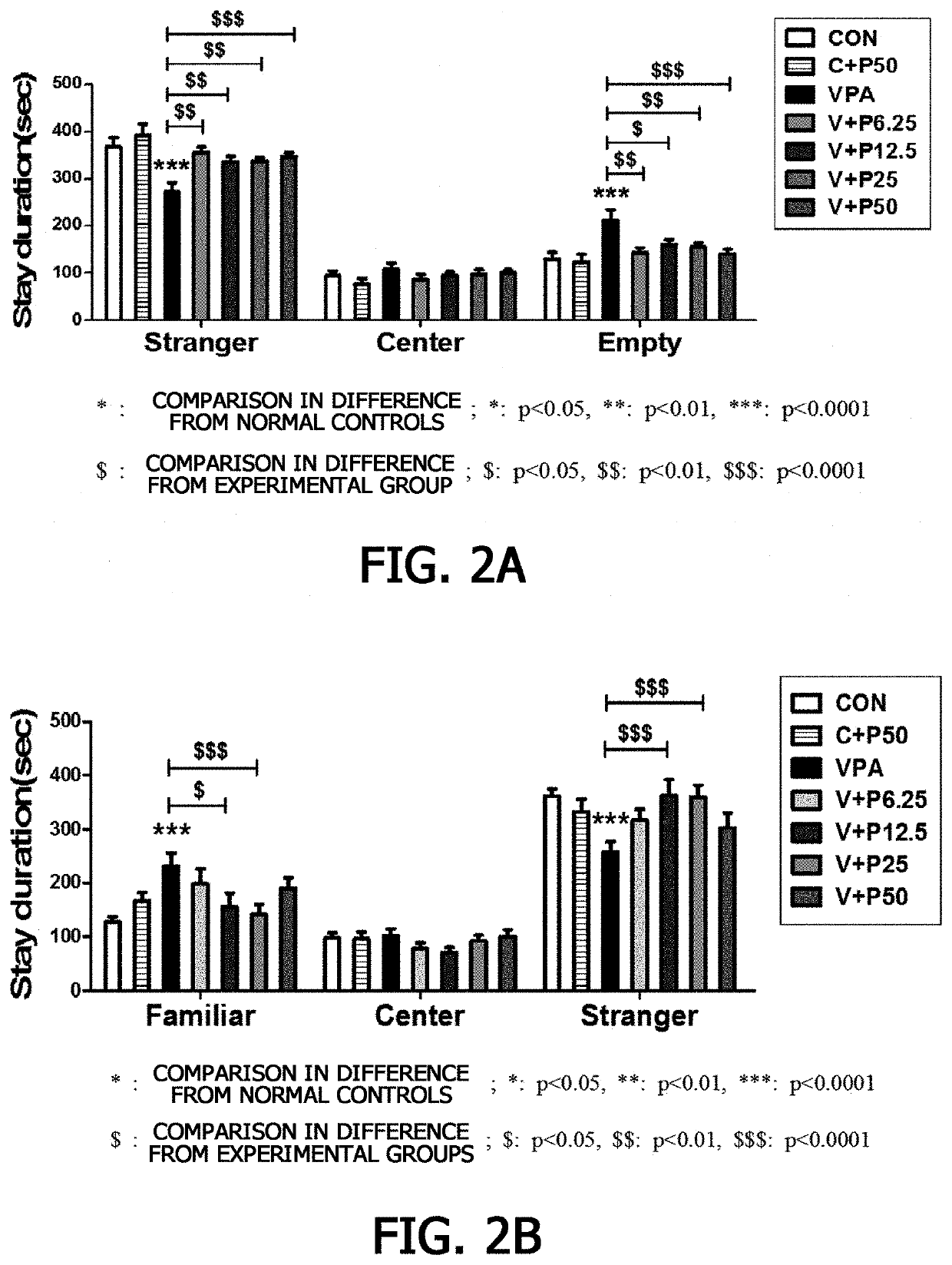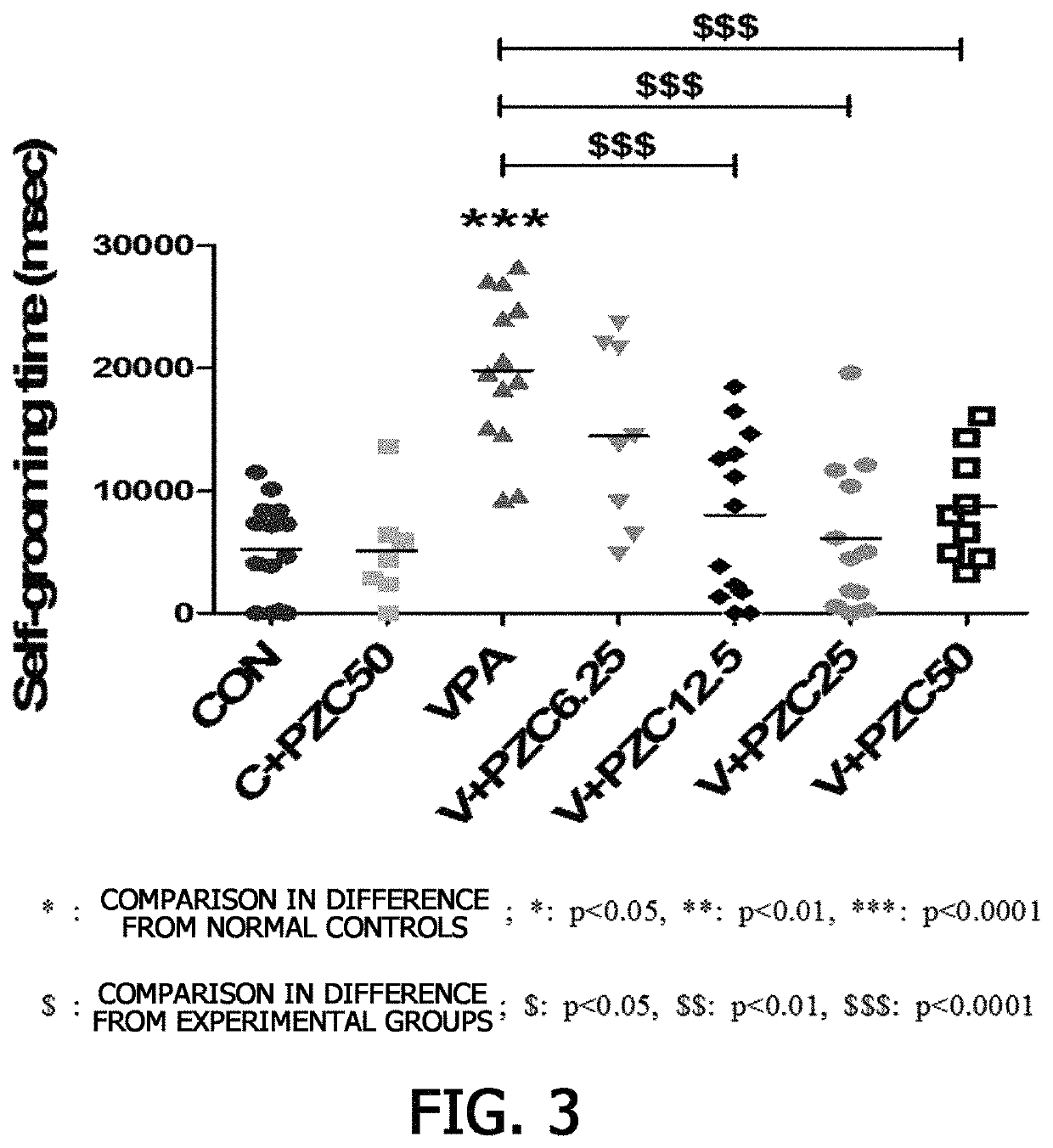Method of treating autism spectrum disorders using piperazine-1-carboxamidine or pharmaceutically acceptable salt thereof
a technology of piperazine and carboxamidine, which is applied in the direction of pharmaceutical delivery mechanism, medical preparations, organic chemistry, etc., can solve the problems of systematic efficacy studies that have never been reported, and no therapeutic agent capable of treating the lack of sociability and repetitive behaviors, so as to improve the degree of social interaction and social preference, reduce repetitive or restricted behaviors, and reduce hyperactivity and impulsive behaviors. , the effect of enhancing the susceptibility to electroshock
- Summary
- Abstract
- Description
- Claims
- Application Information
AI Technical Summary
Benefits of technology
Problems solved by technology
Method used
Image
Examples
example 1
[Example 1] Preparation of Autism Animal Models
[0072] Preparation of Valproic Acid-Induced Autism Animal Models (Valproic Acid Models)
[0073]Genetic and environmental models may be used as models for studying autism spectrum disorder. Among them, valproic acid is known to increase the probability of developing autism spectrum disorder by about 20 times that of normal mothers, when pregnant rat were exposed thereto, and in some studies on causes of autism spectrum disorder, it is known that patients with autism spectrum disorder induced by valproic acid are about 8.9%, and thus autism rat models were prepared using valproic acid to be used as subjects in the present invention.
[0074]In particular, valproic acid was subcutaneously injected into female adult Sprague-Dawley (SD) rats on day 12 of gestation, at a dose of 450 mg / kg and in an administration amount of 10 ml / kg, and then the SD rats gave birth to babies. When the born babies were 21 days old, they were grouped according to bod...
example 2
[Example 2] Social Interaction Test for Piperazine-1-Carboxamidine with Respect to Autism Spectrum Disorder
[0078] Verification of Effect of Piperazine-1-Carboxamidine on Enhancing Social Interaction in Autism Rat Models
[0079]To verify an effect of piperazine-1-carboxamidine on treating autism spectrum disorder in valproic acid-induced autism rat models, changes in social interaction according to whether piperazine-1-carboxamidine was administered or not were examined (Crawley, Jacqueline N. Mental retardation and developmental disabilities research reviews 10.4 (2004): 248-258).
[0080]In particular, in a transparent box structure divided into three compartments, a round cage made of a wire mesh was placed in the opposite compartments, the autism rat models aged between 28 days and 34 days, which had been repeatedly administered piperazine-1-carboxamidine in Example , were placed in the middle compartment, followed by a social experiment for 10 minutes. Conditions and the number of in...
example 3
[Example 3] Verification of Repetitive or Restricted Behavior (Marble Burying Test) Enhancement Effect of Piperazine-1-Carboxamidine on Autism Spectrum Disorder
[0088]It is known that rat generally exhibit grooming by decorating their bodies, but autism rat models excessively exhibit grooming, and in severe cases, it causes hair loss and body wounds (McFarlane, H. G., et al. Genes, Brain and Behavior 7.2 2008: 152-163). To confirm an autism therapeutic effect of piperazine-1-carboxamidine in valproic acid-induced autism rat models based on these findings, a grooming level enhancement effect was evaluated in the autism rat models.
[0089]In particular, the autism rat models of Example , which were administered piperazine-1-carboxamidine and aged between 33 days and 38 days, were placed in a cage (42 cm×29 cm×19 cm) without straw litter and adapted thereto for 10 minutes. Thereafter, the grooming time of the autism rat models was measured for 10 minutes to confirm the degree of repetitiv...
PUM
| Property | Measurement | Unit |
|---|---|---|
| weight | aaaaa | aaaaa |
| time | aaaaa | aaaaa |
| threshold stimulation | aaaaa | aaaaa |
Abstract
Description
Claims
Application Information
 Login to View More
Login to View More - R&D
- Intellectual Property
- Life Sciences
- Materials
- Tech Scout
- Unparalleled Data Quality
- Higher Quality Content
- 60% Fewer Hallucinations
Browse by: Latest US Patents, China's latest patents, Technical Efficacy Thesaurus, Application Domain, Technology Topic, Popular Technical Reports.
© 2025 PatSnap. All rights reserved.Legal|Privacy policy|Modern Slavery Act Transparency Statement|Sitemap|About US| Contact US: help@patsnap.com



